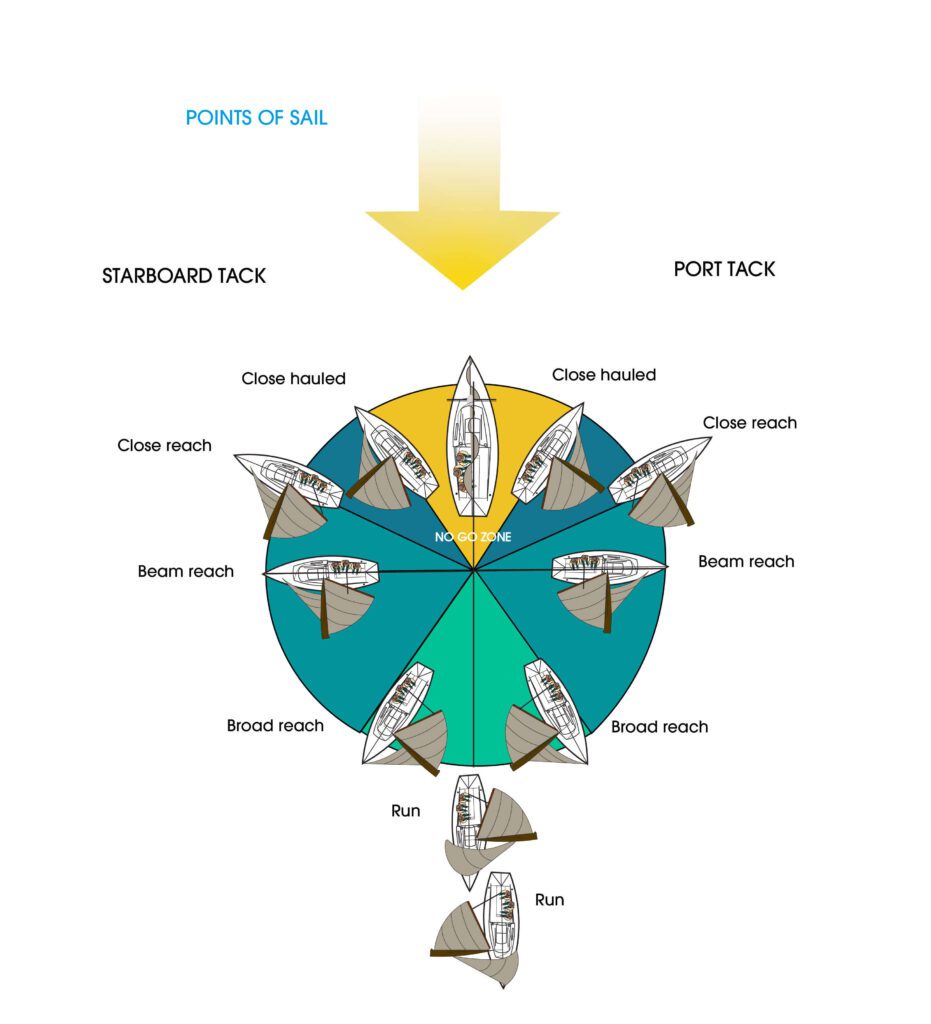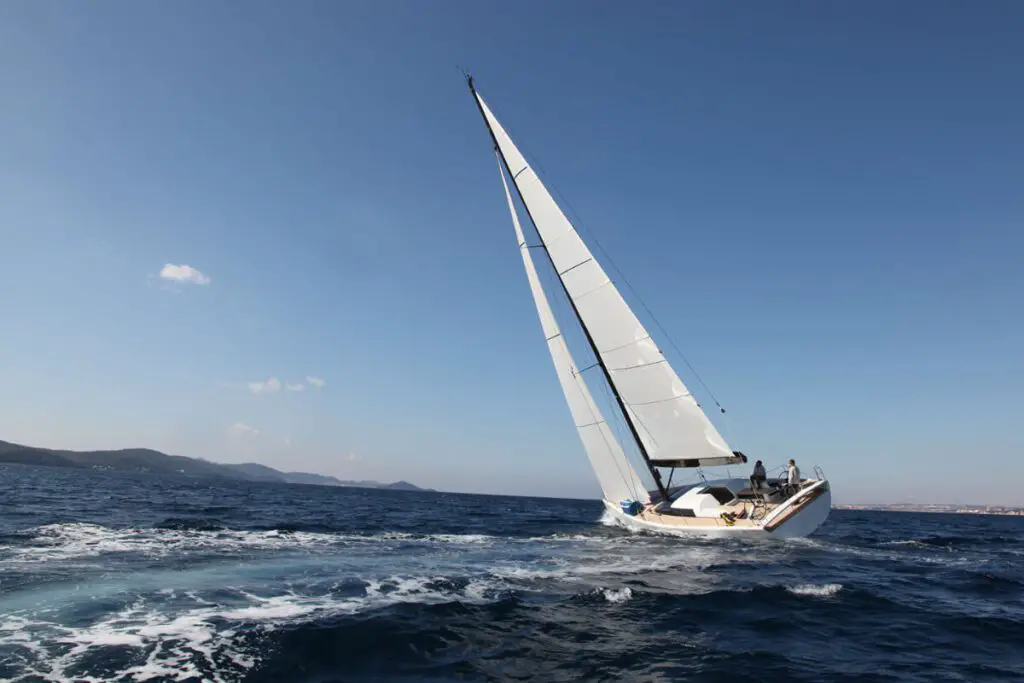One thing I have learned about sailing is that you must know where the wind is coming from to sail the boat properly. When it comes to sailing, there’s more to it than just setting sail and letting the wind take you where it will.
Sailing requires a deep understanding of the wind’s behavior and how it interacts with your sailboat. One of the fundamental concepts every sailor should grasp is the point of sail. Understanding the point of sail empowers you to harness the wind’s power effectively, ensures your safety, and enhances your overall sailing experience.
Table of Contents
- The Basics Of Sailing Explored
- Boat Speed And Performance And Points Of Sail
- Tacking And Jibing And Points Of Sail
- Racing And Performance
- Frequently Asked Questions
- Related Questions
The Basics Of Sailing Explored
If there is no win,d you can not sail. So, before delving into the importance of the point of sail, it is crucial to understand the basics of sailing.
Every sailor must learn the different components of a sailboat, including the mast, boom, rudder, keel, and, of course, the sails themselves. Familiarizing oneself with these elements helps create a solid foundation for mastering the point of sail.
But also with the basics of the sailboat is understanding the wind.
Why Understanding The Wind Is Essential With Sailing?

It may seem like a fundamental thing that you must understand the wind to sail a sailboat, but the truth is that it is not as easy as it seems. Understanding the wind can take time and experience.
Here are some things that are essential to understand with the wind:
Effective Navigation
Knowing the point of sail enables sailors to navigate efficiently, optimizing their course and direction according to the wind’s angle and strength. By understanding how to position their sailboat against the wind, sailors can control their path and reach their destination more swiftly.
Harnessing The Wind’s Power
The point of sail is crucial in determining the sailboat’s angle relative to the wind. By positioning the sail at the optimal angle, sailors can harness the wind’s power to propel their boat forward. Efficiently using the wind’s energy enhances boat speed, conserves fuel, and reduces the environmental impact.

Knowing The Points Of Sail Ensure You Can Safely Sail
By knowing the wind and points of sail, you can also ensure that you can safely sail the sailboat. Here are some ways that knowing the wind and points of sail can help you with your sailing experience.
Avoiding Stalling
Sound knowledge of the point of sail helps sailors avoid stalling, a situation where the sailboat loses forward momentum due to unfavorable wind angles. Stalling can be dangerous, especially in challenging conditions, as it diminishes control over the vessel and increases the risk of capsizing or drifting into hazardous areas.
Preventing Collisions
By understanding the point of sail, sailors can effectively maneuver their sailboats, avoiding collisions with other vessels or stationary objects. The ability to anticipate the wind’s direction and adjust course accordingly is essential for maintaining a safe distance from potential obstacles.
Boat Speed And Performance And Points Of Sail

Wind matters when you are sailing. The points of sail allow you to be able to sail the sailboat properly. Here are some ways points of sail help you with sailing.
Optimizing Speed
The point of sail significantly impacts boat speed. Sailors who can accurately determine the point of sail can position their sailboat to maximize the wind’s force, improving speed and performance.
Upwind Sailing
Sailing into the wind, known as upwind sailing, is made possible by carefully adjusting the point of the sail. By correctly trimming the sails and adjusting the angle relative to the wind, sailors can optimize their boat’s performance when facing windward challenges.
Downwind Sailing
Conversely, when sailing with the wind at your back or downwind, understanding the point of sail allows you to set the sails correctly to capture the wind efficiently. This knowledge aids in maintaining stability and control during downwind sailing.
Tacking And Jibing And Points Of Sail
To properly tack and jib, you must know the points of sail. To tack or jib, you must know the wind’s direction.

Tacking And Points Of Sail
Tacking turns the sailboat’s bow through the wind, enabling it to change direction against the wind. Accurate knowledge of the point of sail is essential for executing a successful tack while minimizing speed loss and maintaining control.
Jibing and Points Of Sail
Jibing involves turning the stern of the sailboat through the wind. A clear understanding of the point of sail is crucial for executing a smooth jibe, as misjudgment can result in sudden and uncontrollable movements, endangering the crew and vessel.
Racing And Performance
Knowing the points of sail is essential when racing. Here are some ways the points of sail are essential:
Racing Strategy
In competitive sailing, understanding the point of sail is paramount for developing effective racing strategies. By analyzing the wind conditions and the optimal point of sail for each leg of the race, sailors can gain a competitive edge, strategically positioning themselves to maximize speed and take advantage of wind shifts.
Sail Trim
Proper sail trim is crucial for maximizing the efficiency of the sails and achieving optimal boat speed. Understanding the point of sail helps sailors adjust the sails’ shape and tension, ensuring they capture the wind effectively and reduce drag, resulting in improved performance.
Balance And Stability
The point of sail influences the balance and stability of the sailboat. By trimming the sails according to the wind’s angle, sailors can maintain a stable and balanced boat, reducing the risk of capsizing or losing control in challenging conditions.
The point of sail is the compass guiding every sailor through their journey on the water. From primary navigation to advanced racing techniques, understanding the wind’s behavior and the optimal positioning of the sailboat about it is essential for a safe, efficient, and enjoyable sailing experience.
Learning the point of sail empowers sailors to navigate effectively, harness the wind’s power, and optimize boat speed and performance. It enhances safety by preventing stalling and collisions while also providing the necessary knowledge to successfully execute maneuvers such as tacking and jibing.
Whether you’re a novice sailor or an experienced mariner, investing time and effort to understand the point of sail will elevate your skills and confidence on the water. So, embrace the wind, master the point of sail, and embark on unforgettable sailing adventures with the knowledge to navigate the seas with expertise. Happy sailing!
Frequently Asked Questions
What is a point of sail in sailing?
A point of sail refers to the angle at which a sailboat is positioned in relation to the direction of the wind. It determines how the wind interacts with the sails and influences the boat’s speed and direction.
Why is understanding points of sail crucial for sailing?
Understanding points of sail is essential because it enables sailors to optimize their sailboat’s performance. By adjusting the boat’s angle to the wind, sailors can achieve the best speed, efficiency, and maneuverability.
How many basic points of sail are there?
There are typically eight basic points of sail, including close-hauled, close reach, beam reach, broad reach, running, dead downwind, and more. Each represents a different angle between the boat’s course and the direction of the wind.
How does knowing the points of sail enhance safety?
Knowing the points of sail helps sailors maintain control and stability, especially in changing wind conditions. Properly adjusting the sailboat’s angle to the wind prevents accidental jibes, reduces the risk of capsizing, and ensures a safer sailing experience.
Can you sail directly into the wind?
Sailing directly into the wind, known as “in irons,” is generally not possible because the sails lose power and the boat stalls. However, sailors can navigate as close to the wind as possible using techniques like tacking.
What is tacking and how does it relate to points of sail?
Tacking is a maneuver where a sailboat changes its direction by turning its bow through the wind. It allows the boat to sail a zigzag course upwind and is crucial for navigating between different points of sail effectively.
How does understanding points of sail affect sail trim?
Proper sail trim, which involves adjusting the sails’ angle and tension, is directly influenced by the boat’s point of sail. Correct sail trim maximizes the sail’s aerodynamic shape and power output, enhancing the boat’s performance.
How do points of sail affect sailboat speed?
The boat’s speed is affected by the angle of the sails to the wind. By selecting the appropriate point of sail, sailors can achieve optimal sail shape and wind capture, leading to increased speed and efficiency.
At A Bus On A Dusty Road, we talk about everything about travel, life, sailing, and ex-pat living. We are all about “Living Life As A Global Citizen.” We explore social, cultural, and economic issues and travel.
We would love to have you be part of our community. Sign up for our newsletter to keep up-to-date by clicking here. If you have any questions, you can contact me, Anita, by clicking here.
Listen to our Podcast called Dusty Roads. You can find it on all major podcast platforms. Try out listening to one of our podcasts by clicking here.
Subscribe to our A Bus On A Dusty Road YouTube Channel filled with great videos and information by clicking here.
Related Questions
All About Sailing In The Philippines
The Philippines has long been a sailors’ paradise for cruising and learning to sail a boat. For 7000 islands, there are many places that you can explore within the Philippines. It can be an area that can hit many typhoons, so to cruise or sail the Philippines, you need to understand the best time to go there.
By clicking here, you can discover All About Sailing In The Philippines.
How Much Wind Is Too Much For A Beginner Sailor?
For a beginner sailor, the wind is usually recommended to be under 10 knots. Those who are more experienced or with a larger boat can consider going up to 12 knots of wind. A knot is not the same as miles per hour or kilometers per hour but is faster than these measurements.
By clicking here, you can discover How Much Wind Is Too Much For A Beginner Sailor?
No Experience Sailing, 6 Tips To Get Started
If you are going to take up sailing, you first must get on a boat and find out if sailing is suitable. The best sailors can handle their boats in all kinds and types of weather. Find a class that you can join and get certified. Sailing requires knowledge and skill. Find yourself a sailing community that you can be part of.
By clicking here, you can discover No Experience Sailing, 6 Tips To Get Started.


